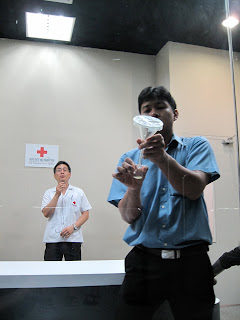
The Institute is a WHO-affiliated organisation manufacturing antivenin. It's disappointingly professional in that all the public action takes place in an antiseptic, snake-proof booth:

This is in stark contrast to the last last snake farm I went to (in Ho Chi Minh City), where the handler's hands were lumpy and mangled from innumerable bites, and his snake-handling technique involved a lot of dodging and flailing about on the restaurant floor. In retrospect, he wasn't a very good snake handler. By comparison, the Institute's handlers still have all their fingers, and their snake-handling technique is cool and professional. They share a catching stick that's about a metre long with a slightly curved piece of wire sticking at a right-angle from the end. They use it to hook a cobra out of its plastic box, then they grab its tail with the other hand. They dangle it by the tail so its head and about two inches of its body rest on the ground, then they use the wire end of the stick to delicately press the cobra's head against the floor. They take the back of its head between the thumb and forefinger of the hand that holds the tail, let go of the stick, transfer the tail to the free hand, and voila; immobilised snake.

Next, they push the snake's fangs through clingfilm stretched over the mouth of a funnel and wait about a minute for it to expel all its venom, while their partner repeats the process:

Three snakes are milked in quick succession, and their venom poured into a beaker the size of a shot-glass:

This venom will, we are told, be distilled and then injected into horses, which will then produce the antivenom. The horses are unfortunately no longer kept on site, so I wasn't able to determine whether they are happy and healthy or mangled and dying, but I choose to believe the former.
(Interesting side-note gleaned from Wikipedia: antivenom production is increasingly shifting away from the use of horses, as enough people are allergic to horses to make the potential for reaction a problem. Sheep are apparently more hypoallergenic.)
okay, this question is painfully reminiscent of that female's question vis-a-vis live-animal vs. scale model, but is that snake in the first picture alive? And what type of snake is it?
ReplyDelete